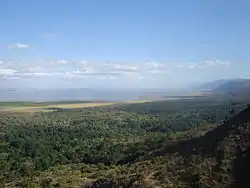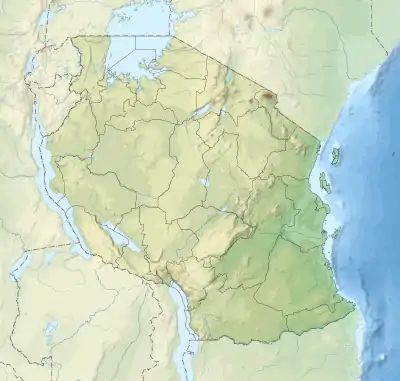Lake Manyara
Lake Manyara is the seventh-largest lake of Tanzania by surface area, at 470-square-kilometre (180 sq mi).[1] It is a shallow, alkaline lake in the Natron-Manyara-Balangida branch of the East African Rift in Manyara Region in Tanzania.[2].The northwest quadrant of the lake (about 200 sq, km.) [3] is included within Lake Manyara National Park and it is part of the Lake Manyara Biosphere Reserve, established in 1981 by UNESCO as part of its Man and the Biosphere Programme. [4]
| Lake Manyara | |
|---|---|
 Overlook of Lake Manyara National Park. | |
 Lake Manyara | |
| Location | Tanzania |
| Coordinates | 3°35′S 35°50′E |
| Lake type | Saline, alkaline, endorheic |
| Primary inflows | Simba River (from the north), Makayuni River (from the east) |
| Max. length | 40 km (25 mi) max |
| Max. width | 15 km (9.3 mi) max |
| Surface area | 181.5 sq mi (470 km2)[1] |
| Max. depth | 3.7 m (12 ft) |
| Surface elevation | 1,045 m (3,428 ft) |

There are differing explanations for how Lake Manyara got its name. The name Manyara may come from the Maasai word emanyara, which is the spiky, protective enclosure around a family homestead (boma). Possibly the 600 m high rift escarpment hems in the lake, like the enclosure around a Maasai boma.[5] Another theory is that the Mbugwe tribe, who live in the Lake Manyara area, may have given the lake its name based on the Mbugwe word manyero, meaning a trough or place where animals drink water.[6]
Hydrology
The lake is in a closed basin with no outflow. It is fed by underground springs and by several permanent streams and rivers that drain the surrounding Ngorongoro Highlands, but the vast majority of the inflow (over 99%) comes from rainfall.[7] The lake's depth and the area it covers fluctuates significantly.[7] At its maximum, during the wet season, the lake is 40 km wide by 15 km with a maximum depth of 3.7 m.[1] In 2010, a bathymetry survey showed the lake to have an average depth 0.81 m, and a maximum depth of about 1.18 m.[7] In extreme dry periods the surface area of the lake shrinks as the waters evaporate and at times the lake has dried up completely.[7] Lake Manyara is a soda or alkaline lake with a pH near 9.5,[8] and it is also high in dissolved salts. The water becomes increasingly brackish in the dry season as water evaporates and salts accumulate.[9] During dry spells, large areas of mud flats become exposed along the shore.[8] These alkaline flats sprout into grasslands, attracting grazing animals, including large herds of buffalo, wildebeest and zebra.[3]
Fish
The main fish species inhabiting the lake are catfish and tilapia.[9] There is a small fishery, but fish only tend to be found near the inflow areas, where salt concentrations are lower.[1] Lake Manyara is the type locality for the endangered fish Oreochromis amphimelas, a species of in the cichlid family, endemic to Tanzania, found in Lake Manyara and a number of other saline lakes with closed basins. Exploitation is prohibited in the parts of Lake Manyara within the National Park and the protected park areas provide important seed stock for the replenishment of fished populations.[10]
Birds
Lake Manyara National Park is known for flocks of thousands flamingos that feed along the edge of the lake in the wet season. At times, there have been over an estimated 2 million individuals of various species of water birds. The following table summarizes the most numerous species, according to the Important Bird Areas factsheet: Lake Manyara.[11]
| Species | Current IUCN Red List Category | Season | Year(s) of estimate | Population estimate | |
|---|---|---|---|---|---|
| Northern Shoveler (Spatula clypeata) | LC | winter | 1995 | 4,650 individuals | |
| Greater Flamingo (Phoenicopterus roseus) | ELC | non-breeding | - | 40,000 individuals | |
| Lesser Flamingo (Phoeniconaias minor) | NT | non-breeding | 1991 | 1,900,000 individuals | |
| Yellow-billed Stork (Mycteria ibis) | LC | non-breeding | 1995 | 1,020 individuals | |
| Great White Pelican (Pelecanus onocrotalus) | LC | non-breeding | 1991 | 200,000 individuals | |
| Black-winged stilt (Himantopus himantopus) | NR | non-breeding | 1995 | 8,367 individuals | |
| Pied Avocet (Recurvirostra avosetta) | LC | non-breeding | 1995 | 4,940 individuals | |
| Chestnut-banded Plover (Charadrius pallidus) | NT | non-breeding | 1995 | 619 individuals | |
| Caspian Plover (Charadrius asiaticus) | LC | winter | 1995 | 3,302 individuals | |
| Ruff (Calidris pugnax) | LC | winter | 1995 | 45,486 individuals | |
| Little Stint (Calidris minuta) | LC | winter | 1995 | 78,675 individuals | |
| Marsh Sandpiper (Tringa stagnatilis) | LC | winter | 1995 | 2,441 individuals | |
| Common Gull-billed Tern (Sterna nilotica) | NR | winter | 1995 | 1,566 individuals | |
| White-winged Tern (Chlidonias leucopterus) | LC | winter | 1995 | 3,283 individuals | |
| Species group - waterbirds | n/a | non-breeding | 1991-1995 | 1,000,000-2,499,999 individuals | |
Visiting Lake Manyara
Lake Manyara can be accessed through Lake Manyara National Park. With an entrance gate that doubles as an exit, the trail into the park is effectively a loop that can be traversed by jeep within a few hours. The trails goes through forests shrublands and marsh, before reaching the shore of the lake. The Rift Valley escarpment provides a spectacular backdrop.
From the nearby town of Mto wa Mbu, through the Cultural Tourism Programme, it is possible to organize a canoe trip on the lake, or a fishing trip to learn traditional fishing methods. Bicycle trips to the east shore of the lake can also be arraigned.[12]
References
- "Source book for the inland fisheries of Africa vol. 1". FAO.
- Foster, A. and C. Ebinger and E. Mbede and D. Rex (August 1997). "Tectonic development of the northern Tanzanian sector of the East African Rift System". Journal of the Geological Society. 154 (4): 689–700. doi:10.1144/gsjgs.154.4.0689.
- https://www.tanzaniatourism.go.tz/en/destination/manyara-national-park
- "Lake Manyara". UNESCO. Retrieved 16 June 2016.
- http://www.tanzania.eu/showpage-tanzania-lake_manyara_national_park.html
- https://www.jamiiforums.com/threads/maana-ya-manyara.60552/
- Deus, Dorothea; Richard Gloaguen and Peter Krause (2013). "Water Balance Modeling in a Semi-Arid Environment with Limited in situ Data Using Remote Sensing in Lake Manyara, East African Rift, Tanzania". Remote Sensing. 5: 1651–1680.
- Hughes, R. H.; Hughes, J. S. (1992). A directory of African wetlands. UNEP. p. 255.
- https://www.lakelubbers.com/lake-manyara-1672/
- Bayona, J.D.R. 2006. Oreochromis amphimelas. The IUCN Red List of Threatened Species 2006: e.T60629A12388607. https://doi.org/10.2305/IUCN.UK.2006.RLTS.T60629A12388607.en. Downloaded on 24 April 2019.
- BirdLife International (2019) Important Bird Areas factsheet: Lake Manyara. Downloaded from http://www.birdlife.org on 24/04/2019
- http://mtoculturalprogramme.tripod.com/id3.html